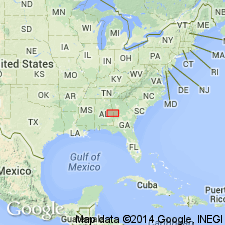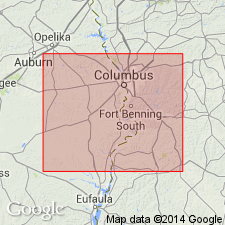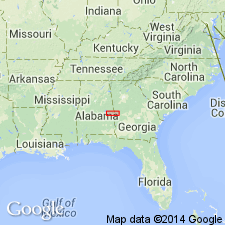
- Usage in publication:
-
- Uchee Complex
- Modifications:
-
- Named
- Dominant lithology:
-
- Migmatite
- Gneiss
- AAPG geologic province:
-
- Piedmont-Blue Ridge province
Summary:
Name credited to unpublished report on Lee Co., AL, by Bentley. Adams (1933) and Crickmay (1952) referred to rocks of the Uchee block as the Uchee Belt. Bentley (unpublished report) designated all rocks south of Goat Rock fault zone as belonging to Uchee block and subdivided it into Moffits Mill Complex and Uchee Complex. Occurs in eastern AL and western GA. Subdivided into Mulberry Gneiss, Phenix City Gneiss, Standing Boy Quartz Diorite, and Hudson Rapids Ultramafic Amphibolite. Phenix City Gneiss is most dominant unit; it is intruded in AL by granodioritic Hospilika plutons.
Source: GNU records (USGS DDS-6; Reston GNULEX).

- Usage in publication:
-
- Uchee
- Modifications:
-
- Not used
- AAPG geologic province:
-
- Piedmont-Blue Ridge province
Summary:
Uchee Complex of Bentley and Neathery (1970) not used. New and revised nomenclature consists of North Columbus Gneiss Complex (top), Bypass Metamorphic Complex (both first used), and Phenix City Gneiss.
Source: GNU records (USGS DDS-6; Reston GNULEX).

- Usage in publication:
-
- Uchee Complex
- Modifications:
-
- Overview
- AAPG geologic province:
-
- Piedmont-Blue Ridge province
Summary:
Type area stated as Lee Co., east-central AL. Consists of coarsely crystalline, highly contorted migmatitic gneiss and schist. Subdivided into Phenix City Gneiss, an unnamed amphibolite, and Hospilika Granite.
Source: GNU records (USGS DDS-6; Reston GNULEX).

- Usage in publication:
-
- Uchee Complex*
- Modifications:
-
- Overview
- Age modified
- AAPG geologic province:
-
- Piedmont-Blue Ridge province
Summary:
Authors follow terminology of Bentley and Neathery (1970). Uchee Complex of the Uchee belt consists of Mulberry Gneiss, Phenix City Gneiss, informal Standing Boy quartz diorite (mapped together with Phenix City Gneiss), and informal Hudson Rapids amphibolite (mapped together with other amphibolites). Units are intruded by Hospilika Granite plutons. Report includes geologic map. Age is early Paleozoic. [Remark reflects published version. GNU review asked that informal units be inverted, but request was not followed by authors. Mulberry, Standing Boy, and Hudson Rapids should remain informal terms.--edk 01/24/94]
Source: GNU records (USGS DDS-6; Reston GNULEX).
For more information, please contact Nancy Stamm, Geologic Names Committee Secretary.
Asterisk (*) indicates published by U.S. Geological Survey authors.
"No current usage" (†) implies that a name has been abandoned or has fallen into disuse. Former usage and, if known, replacement name given in parentheses ( ).
Slash (/) indicates name conflicts with nomenclatural guidelines (CSN, 1933; ACSN, 1961, 1970; NACSN, 1983, 2005, 2021). May be explained within brackets ([ ]).

